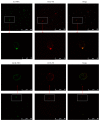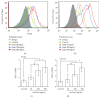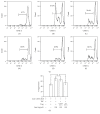Growth Arrest-Specific 6 Enhances the Suppressive Function of CD4+CD25+ Regulatory T Cells Mainly through Axl Receptor
- PMID: 28270700
- PMCID: PMC5320320
- DOI: 10.1155/2017/6848430
Growth Arrest-Specific 6 Enhances the Suppressive Function of CD4+CD25+ Regulatory T Cells Mainly through Axl Receptor
Abstract
Background. Growth arrest-specific (Gas) 6 is one of the endogenous ligands of TAM receptors (Tyro3, Axl, and Mertk), and its role as an immune modulator has been recently emphasized. Naturally occurring CD4+CD25+ regulatory T cells (Tregs) are essential for the active suppression of autoimmunity. The present study was designed to investigate whether Tregs express TAM receptors and the potential role of Gas6-TAM signal in regulating the suppressive function of Tregs. Methods. The protein and mRNA levels of TAM receptors were determined by using Western blot, immunofluorescence, flow cytometry, and RT-PCR. Then, TAM receptors were silenced using targeted siRNA or blocked with specific antibody. The suppressive function of Tregs was assessed by using a CFSE-based T cell proliferation assay. Flow cytometry was used to determine the expression of Foxp3 and CTLA4 whereas cytokines secretion levels were measured by ELISA assay. Results. Tregs express both Axl and Mertk receptors. Gas6 increases the suppressive function of Tregs in vitro and in mice. Both Foxp3 and CTLA-4 expression on Tregs are enhanced after Gas6 stimulation. Gas6 enhances the suppressive activity of Tregs mainly through Axl receptor. Conclusion. Gas6 has a direct effect on the functions of CD4+CD25+Tregs mainly through its interaction with Axl receptor.
Conflict of interest statement
The authors declare that there is no conflict of interests regarding the publication of this paper.
Figures







References
MeSH terms
Substances
LinkOut - more resources
Full Text Sources
Other Literature Sources
Research Materials
Miscellaneous

